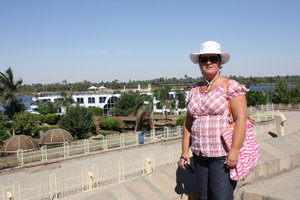Advertisement
Published: September 23rd 2009

 Michele at Kom Ombo
Michele at Kom Ombo
The picture was taken at the temple at Kom Ombo.We left Aswan the night before and cruised to Kom Ombo. We enjoyed seeing the countryside when we woke with fishermen and farmers hard at work. Kom Ombo is 40 kilometers (28 miles) north of Aswan and since earliest times, has received visitors who have traveled through the Libyan and Arabian deserts from Sudan. The town of Kom Ombo was built on a high dune overlooking the Nile and gained importance during the Ptolemic age as it protected the southern border of Egypt and in the Roman period was a military station.
Following breakfast we began the day with a visit to Kom Ombo. We got up early to beat the heat, but we did not beat the villagers who were lined up parading their treasures to sale. It seems like each day, they get more desperate and aggressive. We have learned you can not make eye contact with them or slow down or that is it! They will attack like phiranas. They will wrap you with scarves and refuse to take them back until you pay. I actually had to drop one on the ground because the man refused to take it back! Our entire group has began to

 Missy at Kom Ombo
Missy at Kom Ombo
Our riverboat is in the background.hate this part of our trip. We dreaded getting off the boat to visit another temple because of how forceful these men are. While we were trying to get away from the villagers, we walked right up on a COBRA! An elderly Egyptian man was sitting beside a step on a blanket. Next to him was his COBRA all curled up and hissing! Some members of our group did not even notice it because they were being bombarded by the villagers. I so wanted to stop and get a picture with him, but I did not have any money out. I knew that would be a condition for my picture. I knew if I stopped then, I would never get away from the other men to join my group, so I convinced myself I would get his picture on the way back to the river boat. I would have my camera ready along with my money in hand.
Anyway, the reason we docked here was to visit the temple dedicated to Sobek the Crocodile god and Haroeris the winged god. The temple was just a short distance from the river where our boat docked. The temple was beautiful and

 Our tour group
Our tour group
This is the only group picture we took and it is in front of the temple at Kom Ombo.the view was breathtaking with all the boats lined up in front of it. The Temple of Kom Ombo is an unusual double temple built during the Ptolemaic dynasty in the Egyptian town of Kom Ombo. The building is unique because its 'double' design meant that there were courts, halls, sanctuaries and rooms duplicated for two sets of gods. The southern half of the temple was dedicated to the crocodile god Sobek, god of fertility and creator of the world with Hathor and Khonsu. This was why the temple was called both "House of the Crocodile" and "Castle of the Falcon".
After returning to the cruise ship we continued to sail to Edfu. After lunch, we took another excursion in Edfu to visit the Temple of Horus. The Temple of Horus in Edfu (also known as the Temple of Edfu) is considered the best-preserved cult temple in Egypt. This partly because it was built later than most: in the Ptolemaic era from 237 to 57 BC.
Yet despite its later date, it exactly reflects traditional pharaonic architecture and provides an excellent idea of how all the temples once looked. Edfu is also very large: the second largest in

 The temple at Kom Ombo
The temple at Kom Ombo
This picture was taken as we departed on our riverboat.Egypt after Karnak Temple.
The falcon-headed Horus was originally the sky god, whose eyes were the sun and moon. He was later assimilated into the popular myth of Isis and Osiris as the divine couple's child. Raised by Isis and Hathor after Osiris' murder by his brother Seth, Horus avenged his father's death in a great battle at Edfu. Seth was exiled and Horus took the throne, Osiris reigning through him from the underworld. Thus all pharoahs claimed to be the incarnation of Horus, the "living king."
The Temple of Edfu was abandoned after the Roman Empire became Christian and paganism was outlawed in 391 AD. It lay buried up to its lintels in sand, with homes built over the top, until it was excavated by Auguste Mariette in the 1860s. The sand protected the monument over the years, leaving it very well preserved today.
By MIssy
Advertisement
Tot: 0.073s; Tpl: 0.011s; cc: 11; qc: 49; dbt: 0.0434s; 1; m:domysql w:travelblog (10.17.0.13); sld: 1;
; mem: 1.2mb

 Michele at Kom Ombo
Michele at Kom Ombo
 Missy at Kom Ombo
Missy at Kom Ombo
 Our tour group
Our tour group
 The temple at Kom Ombo
The temple at Kom Ombo




























